Thanks to those who replied to my previous post…and my decision is: to wiki. It’s relatively easy to make the Wiki look as good (and I use the term good loosely) as the non-Wiki scenery website. By comparison, it would be very complex to make the scenery web-site interactive and faster to update. (And update ease is very important – one of the reasons why there is so little documentation on the scenery website is that it is so hard to document.)
So…as a beginning, I have reskinned the wiki. (If you want the old look, create an account and pick the old skin, called “monobook” in your preferences.) If you don’t like the new look, you can send me a new style sheet or even an existing MediaWiki 1.9-compatible skin…I can install it and can select it in your preferences.
I have also installed some extensions that should help add additional flexibility (for example, the Wiki can now have image-based links). Over the next few days I will try to clean up the front page a bit to provide a clearer navigation structure.
One thing we will need on the Wiki is…
WikiGnomes – that is, users who help to organize and polish the content for readability.
In the long term, I would like to migrate scenery.x-plane.com to the Wiki. But for now that is lower priority than creating new documentation.
Posted in News
by
Ben Supnik |
If you run X-Plane 9.21 (or 9.22) on a Macintosh with an old ATI or nVidia graphics card (with no pixel shaders), you somehow squeeze 25 fps out of X-Plane*, and you can try a test build, please email me.
Those cards include:
- Radeon 7000-9200, inclusive.
- GeForce 2, 3, or 4 series.
I have a change in the panel code that I need to performance test against older hardware!
* Basically you would have to really crank the settings down – but I think under some really baseline settings these machines might be able to run X-Plane 9 without fogging.
Posted in News
by
Ben Supnik |
You might not believe this (due to the general lack of scenery system documentation) but I do spend some brain power thinking about X-Plane documentation for third parties!
Consider two approaches to documentation:
My question is: which of these approaches is more “readable” or “clear” to you as a third party? Each one (the formal website vs. the Wiki) has pros and cons, but I can’t judge “usability” of the documentation myself. Is it easier to find things on the website? On the Wiki? Comments welcome!
(I need to decide where to put future documentation, hence the question “which works better for those who read the documentation.)
Besides X-Plane for iPhone (which I now call “X-Plane general aviation” to avoid confusion) there are now two new apps: X-Plane Airliner and X-Plane Helicopter. The helicopter version uses part of the Grand Canyon and the airliner version uses part of Southern California.
All three apps (the general aviation version has a free update) have a fix in the DSF lower that should help avoid crashes.
Basically while X-Plane used to run under memory limits for the phone, it would temporarily go quite a bit over memory the limit during the DSF load, as the DSF loader would use some temporary memory. The new code very carefully purges temporary memory as it runs, and thus never exceeds its final memory footprint. Before 9.04 there was always a risk that your phone was in a tight memory situation to begin with, such that X-Plane going “over budget” would cause the OS to kill it off. (Rebooting the phone apparently purges memory or something.)
So…this is a long-winded way of saying: if you update X-Plane iPhone to 9.04 and still have the app quit at launch (or right after launch), please send us a crash report!
It looks to me like we could afford a few landing light halos on most (but not all) hardware. This gets a bit tricky in terms of how we make this available to authors…
- We have to allow access without breaking old planes.
- There will be two distinct cases due to very different hardware.
So…I have posted an RFC on the X-Plane Wiki. Please post your thoughts on the discussion page!
One option (not really discussed in the RFC) is to do nothing at all. Basically I hit upon this during some routine refactoring of the shaders. The whole issue can be deferred indefinitely.
Why wait? Well, I don’t believe that an incremental increase in the number of landing light halos is the future. Our end goal must be some kind of truly global illumination, hopefully without a fixed lighting budget. It may not make sense to add a bunch of complexity to the aircraft SDK only to have all of those limit become unnecessary cruft a short time later.
(I think I can hear the airport designers typing “why do the airplane designers get four lights and we get none? Give us a light or two!” My answer is: because of the fixed budget problem. We can allocate a fixed budget of lights to the user’s aircraft because it is first in line – we know we either have the lights or we don’t. As soon as we start putting global lights in the scenery, we have to deal with the case where we run out of global lights. For scenery I definitely want to wait on a scheme that isn’t insanely resource limited!)
Programmers: yes – Dx10 hardware can do a hell of a lot more than 4 global lights. Heck – it can do a hell of a lot period! For example, it can do deferred rendering, or light pre-rendering. A true global lighting solution might not have anything to do with “let’s add more global lights a few at a time.”
Every time I work on a new X-Plane feature, I do a combination of:
- Reorganizing and cleaning up old code.
- Adding new features.
- Tuning performance for this new environment.
My experience has been that the investment in cleaning up old code is more than paid for by faster, easier development of new code – it’s easier to code in a “clean” work area.
As part of my work on 930 I am refactoring and optimizing how we set up pixel shaders. I’m not sure if there will be any framerate benefits in the short term, but in the long term there is definitely an advantage to being able to set up the most optimal shader configuration for any situation.
(Since most of what we draw – OBJs, airplanes, DSFs) can be created by users, we never really know what we’ll be drawing…the set of art content X-Plane can handle is almost unlimited. So it is up to shader optimization code to “find” the optimal setup for a particular stew of OBJ attributes, textures, etc.)
The short term fall-out during beta is unfortunately a certain amount of pain. It’s likely that these changes will introduce graphic quirks with certain combinations of planes. These are fixable! The important thing is: if you hit a graphics bug with a particular plane or scenery pack in 930 (whenever we get to beta – we are not in beta yet!) and that bug is not in 921 – report it! It may be that the optimizer is being too aggressive with a particular combination of settings and turning off some critical feature.
I will run the new shader optimizer code through just about every scenery pack and airplane I can find, but invariably there is some magic trick in a third party plane on the .org that I won’t have.
One thought for creating fast content: alpha is expensive! Or rather, let me rephrase that to: if you are not using the alpha channel of your texture, you should not have an alpha channel in your texture.
(For PNG this means stripping the alpha channel off, rather than having a solid 100% opaque alpha channel. For DDS this means using DXT1 with no transparent pixels.)
The new shader optimizer detects the case where alpha is not being used and sets up a more optimal code path. (The old shader optimizer did that too, but only some of the time – in the new code, we will always take this optimization.)
Having alpha blending enabled can inhibit “early-Z” optimizations on modern GPUs, and also require a more expensive blending operation in the framebuffer.* So if your model doesn’t use alpha, strip the channel.
* Some newer graphics cards recognize 100% opaque alpha and provide fast write to the framebuffer. But even if early-Z-type optimizations become alpha friendly, there will still be optimizations we can make in the sim if we hit the no-alpha case.
I want to revisit the question of whether (and how) the livery system should be extended. In particular, it is my opinion that the livery system should not be extended to allow:
- Replacement of OBJs used for modeling the airplane or cockpit.
- Alternate or modified ACFs*.
- Generally, the livery system shouldn’t be used for changing the plane’s behavior – it’s just paint!
I have commented previously in three parts that the livery system is meant to make easy the integration of third party paint without (a) violating copyright, (b) requiring byzantine installation instructions or (c) requiring the painter and original author to coordinate. I have received requests from a number of very talented airplane authors, asking for the livery system to cover a whole range of new features, most of them involving configuration. I will try to explain in this post how I think should should be handled.
First, to be clear: an aircraft file is the .acf file that contains the X-Plane specific data needed to simulate the plane; the aircraft package is the folder containing that .acf file. A livery is a painting scheme for the 3-d model of the airplane, and a configuration is an instance of a plane with certain features, e.g. with or without G1000, with P&W; vs. Rolls Royce engines, etc.
Configurations of an aircraft should be created by putting more than one aircraft file
(.acf) in a single aircraft package. Because the graphic and sound resources needed for the aircraft are accessed relative to the .acf file, you can build a family of aircraft with some common aspects and some unique aspects to each plane.
Files used by an aircraft fall into three broad categories:
- Files found by a fixed formula using the .acf name, e.g. be20_paint.png. Let’s call these “file-specific”.
- Files found by a fixed formula without using the .acf name, e.g. the contents of the aircraft plugins folder. Let’s call these “package specific”.
- Files that are explicitly named in the .acf file, like airfoils and OBJs. Let’s call these “flexible” (since this naming scheme could be used in any way).
Here’s how the important files in an aircraft break down:
- The aircraft paint scheme is file specific.
- The aircraft panel background is package specific (but you can effectively have each file use a different panel background by setting the panel type differently for each plane).
- Sounds are actually either, which effectively makes them flexible. Non-generic instruments are package-specific.
- Objects, generic instruments and airfoils are flexible.
In other words, if you can live with duplicating your aircraft paint files (and I suspect that in most cases either the plane is built by objects, or the modifications in each configuration warrant paint changes anyway), then every other feature can be set to package or file specific, allowing you to build a group of aircraft around a single real-world plane.
Now if there are aspects of a multi-configuration aircraft package that don’t work right now, we can look at possible changes to the sim to make this work. But it appears to me that just about everything necessary to make multiple configurations is already available in the sim now.
As a final note, the question here (livery vs. multi-file aircraft pack for configurations) is one of file formats, and thus of data organization and contracts between authors and programmers. It is not a question of user interface. The user interface can be reshaped to make multi-aircraft packages look like liveries, or liveries look like multi-aircraft packages. But I suspect that most of the interest in extended liveries is on the file-format side.
* The one exception for liveries is the tail number — given the strange state where the tail number, as painted into the livery, is also written into the ACF, it wouldn’t be bad to be able to override this property. Some people are already doing this using plugins.
Some coding problems are stubborn – I find myself looking back at a week of working realizing that all I really did was prove that a bunch of theoretical improvements don’t work in practice.
Improving OBJ throughput is one of those problems. On a high-end machine, even drastic changes to the OBJ engine make only the slightest difference in throughput – 2 or 3% at best. Every improvement counts, but a 3% improvement doesn’t change the game for how we draw scenery.
There is at least one route I haven’t had time to go down yet: object instancing. The theory is that by making many objects appear with only one object drawn, we get a multiplier, e.g. a 2x or 4x or larger amplification of the number of objects we can have.
In practice it won’t be that simple:
- To get such an amplification we have to recognize groups of the exact same object. Grouped objects will have to be culled together. So we might get a hit in performance as we draw more objects that are off-screen, just to use instancing.
- It may be that the grouping requirement is so severe that it is not practical to find and group objects arbitrarily (instead we would have to group objects that are built together, like clusters of runway lights). That might limit the scope of where we can instance.
- The objects have to look more or less the same, so some categories of very complex objects won’t be subject to instancing. (E.g. objects with animation where each object might look different.)
- I have already coded some experiments with geometry shaders, and the results are just dreadful – geometry shaders simply don’t output a huge number of vertices efficiently, so they don’t help us increase our total vertex throughput. The experience has left me with a “prove it” attitude toward GL extensions that are supposed to make things faster.
When will we know whether instancing can help? I don’t know — I suspect that I won’t be able to find time for code experiments for a bit, due to other work, particularly on scenery creation and tools.
A hidden detail of my previous post on variation and terrain textures: variation for flat textures was implemented using more triangles in the DSF in X-Plane 8, but is implemented in a shader in X-Plane 9. This means that you don’t get this feature in X-Plane 9 if shaders are off.
My guess is that this is perfectly acceptable to just about every user.
- If you don’t have shaders, you have something like a GeForce 4 or Radeon 8500, and are fighting for frame-rate. In this case, not paying the price of layer-based variation is a win.
- If you have shaders, you’re getting better performance because the shader creates variation more efficiently than the old layering scheme did.
This kind of move of a feature to the GPU can only happen at major versions when we recut the global scenery, because (to utilize the benefit) the DSFs are recut with fewer (now unneeded) layers. So features aren’t going to mysteriously disappear mid-version.
I do have a goal to move more layering-type features to the GPU for future global scenery renders. There are a number of good reasons:
- DSF file size is limited – we have distribution requirements on the number of DVDs we ship. So DSF file size is better spent on more detailed meshes than on layers.
- GPU power is increasing faster than anything else, so it’s good to put these effects on the GPU – the GPU is still hungry for more!
- If a feature is run on the GPU, we can scale it up or down or turn it on or off, for more flexible rendering settings on a wide variety of hardware. A feature baked into the DSF is there for everyone, no way to turn it off.
My hope for the next render is to (somehow) move the cliff algorithm (which is currently done with 2-4 layers) to the GPU, which would shrink DSFs, improve performance, and probably create nicer looking output.
In my previous post I discussed variation as a way to hide the artifacts of land use texturing. Now we can talk about this bug.
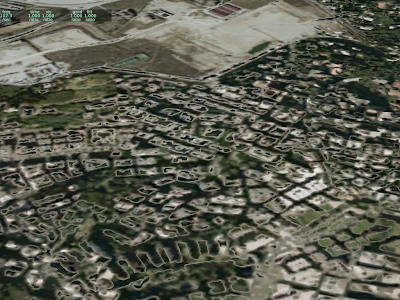
What are these weird artifacts that show up over the terrain when shaders are on? Well, they should (and will in 930) look like this:
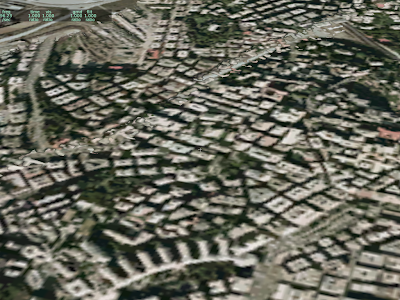
But what’s going on? The answer is auto-variation.
In X-Plane 8, variation is created by using multiple layers, each one applying a texture at a different offset. This technique works on a wide range of hardware, but is inefficient – it causes overdraw (which we know is
very bad).
So in X-Plane 9 I replaced this layer-based variation with a pixel shader algorithm. This means less information in the DSF (which means smaller DSFs, faster loading and less RAM use), but it also means variation is only visible to those with shaders. Having the pixel shaders create variation dynamically on the GPU is called “auto-variation” (and is invoked via the AUTO_VARY command in a .ter file).
The artifact above was a bug in the auto-variation shader. With the code now fixed (the 930 patch will contain the fix), here are some images of how it is supposed to work:
Here we have the texture in question, at two different offsets.
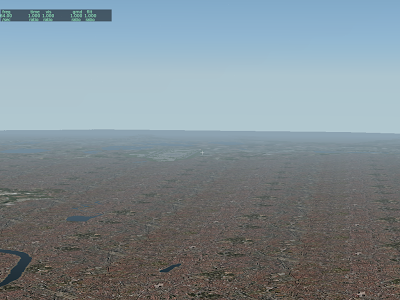
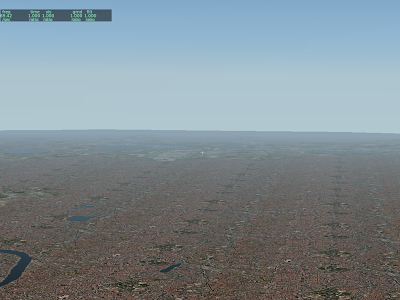
This black and white texture is the “mixing mask” used to select which offset to use.
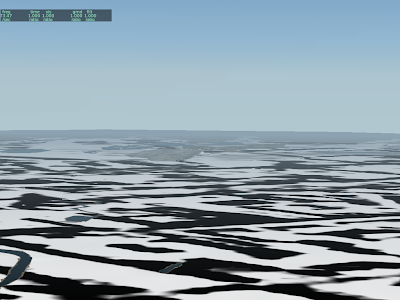
And this is the final result.
There is a little bit more disruption in the columns of green park.





